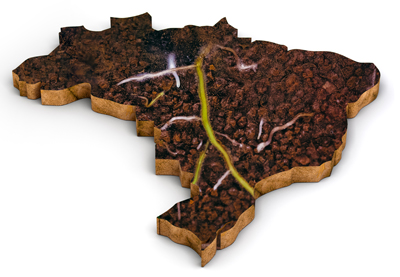Brazil’s Strong Showing

Scroll Down to Read
 By Rick Melnick
By Rick Melnick
Chief Operating Officer & Partner
DunhamTrimmer
Regardless of your base of operations, if people are talking about biologicals, they are talking about Brazil. In 2023, DunhamTrimmer was invited to give presentations in the Americas, Europe, and India. In every case, people were asking us the same thing:
“What is going on with biologicals in Brazil? How can we replicate that here?”
On the surface, the answer to the first part of that question is pretty simple. The biologicals boom in Brazil is no accident. A big part of it is the result of converging factors – timing, opportunity, and forced-upon, practical experience, but behind all of that, it is the Brazilian government that is the largest contributor to the market’s success.
As for the second half of that question, well…
When we assess the value of any biologicals market, we look for five major drivers:
- Government Support (policy, strategic initiatives, etc.)
- Regulatory Framework (federal and/or state)
- Educational Programs (across stakeholders)
- Financial Incentives (across stakeholders)
- Commercial Development (R&D & innovation)
Even an investor without a lot of working knowledge of agriculture, much less biologicals, can look at that list and nod. Most of the markets we look at are really hitting on one or two of those drivers. But Brazil is hitting on all five because of the support it is getting from #1.

Rapid Growth of Brazil’s Biologicals Market
The size of the biologicals market in Brazil has doubled since the launch of the National Bioinputs program in 2019.
For the period 2023 – 2027, DunhamTrimmer estimates an 18.3% CAGR for biocontrols, a 12.3% CAGR for
biostimulants, and a total biologicals market CAGR of 16.7%.
Driver 1: Government Support
The beginning of Brazil’s biologicals story really dates back to December 2009 when Brazil signed the 2009 Copenhagen Accord at COP15 – the 15th Conference of the Parties to the United Nations Framework Convention on Climate Change (UNFCCC). Brazil was among a group of countries that played a significant role in drafting the Accord – not a formal treaty, but a political agreement through which participating countries promised to reduce carbon emissions by cutting or limiting greenhouse gas.
A few years later, a trial-by-fire introduction to biologicals occurred when Brazil suffered an outbreak of the invasive pest Helicoverpa armigera (cotton bollworm, corn earworm), first in cotton and then soybeans. In response to the new threat, growers tended to overuse available insecticides (many of them pyrethroids) and soon were facing widespread and highly resistant populations across Brazil.
A solution came in the form of biologicals, in particular Bacillus thuringiensis spp. kurstaki, or Btk. Btk was affordable, straightforward, and highly efficacious in dealing with Helicoverpa. With growers across Brazil suddenly being thrust into high-Bt use rate circumstances, the potential for biologicals had an immediate proving ground, and while Helicoverpa would go on to cost Brazil hundreds of millions of dollars, the role of bioinsecticides mitigating the damage made an indelible mark on Brazilian agriculture. That baseline of practical experience continued to expand as growers began to evaluate bionematicides to replace conventional products that were facing that same pressure from resistance.
In 2019, Brazil’s Ministério da Agricultura e Pecuária (MAPA), brought everything together by launching Brazil’s National Bioinputs Program (NBP), which would lay the foundation for the eventual boom. But in our view, what differentiates the government support driver in Brazil is that it was not just the Ministry of Agriculture trying to effect change. That commitment started one level higher. The government’s commitment to the Copenhagen Accord, and its resultant shift of resources toward federal climate change and sustainable development goals was a catalyst for the NBP, just one example of coordinated plans from every government sector designed to promote biodiversity and reducing greenhouse gas emissions, chemical use, and environmental impact. It has been from the federal government’s support that all of Brazil’s other drivers emanate.
Driver 2: Regulatory Framework
This brings us to the second driver – a regulatory framework geared toward promoting bioinput technologies. One critical aspect of the NBP was to streamline the process by which biological products are regulated in Brazil, and to prioritize biologicals among new submissions. This focus has brought about commendable results. In a regulatory climate where a new microbials registration takes between 1-2 years in the U.S. and as many as 10 years in the EU, DunhamTrimmer clients are reporting their Brazil submissions are now being processed in less than a year, sometimes in as few as 10 months.
This has far-reaching implications with the numerous bioinput suppliers (local and global) jockeying for position to capture a piece of this high-growth market. The years 2022 and 2023 each saw around 90 new bio-based products registered in Brazil, bringing its total number of registered biologicals to almost 700. Bioinsecticides and bionematicides account for more than half of Brazil’s biocontrol market and about one-third of its biologicals market overall. We forecast these segments will continue to accelerate and that bioinsecticides and nematicides will account for as much as 70% of Brazil’s biocontrol market by 2029.

Brazil Biologicals: A First in Row Crops
One of the most significant aspects of Brazil’s growth in biologicals is use in row crops. Brazil marks the world’s first and only market where row crops are the dominant crop group for biopesticides.
Driver 3: Educational Programs
Our third driver is educational programs and is another area in which the NBP has set Brazil apart. In addition to playing an advisory role to the Brazilian government on agricultural policy and regulation, Embrapa (Empresa Brasileira de Pesquisa Agropecuária), Brazil’s state-owned Brazilian Agricultural Research Corporation, affiliated with MAPA, is also called upon by the NBP to expand and strengthen the adoption and use of bioinputs, in part through training programs.
Through workshops, field days, publications, and digital platforms, Embrapa educates the agricultural community on the practical application and advantages of bioinputs. In addition to the government hiring and training hundreds of new agronomists to support the push toward biologicals, considerable resources have also been spent to facilitate connections between bioinput producers and farmers. These connections are crucial for transferring knowledge from research institutions to the field, ensuring farmers understand the differences between biologicals and conventionals, and how to effectively utilize bioinput technologies.
Looking to the future, the NBP has also given rise to numerous online training courses to build knowledge and understanding of biologicals with the next generation of field personnel. More than 10,000 students have enrolled in bioinput courses developed by the National Bioinputs Program. These efforts extend beyond Brazil’s borders. Embrapa also collaborates with domestic and foreign universities, private companies, and international research institutions to advance the development and application of bioinputs. Brazil’s participation in MERCOSUR (Southern Common Market) includes an initiative to translate its training courses into three languages, which can contribute to the training of technicians and producers from other regions of the world.
Driver 4: Financial Incentives
Financial incentives can take many forms – both direct and indirect. For example, a timely and efficient registration process offers bioinput manufacturers significant financial incentives relating to speed to market. Potential tax breaks or tax reductions could also lower the cost of production and market entry for bioinput products. The specific details of these tax incentives, including eligibility criteria, the extent of the tax breaks, and which bioinput products qualify, are still in flux, but they are part of the government’s broader agricultural and environmental policy frameworks aiming to facilitate biologicals adoption.
In 2021, to promote investment in the agribusiness sector, Brazil introduced FIAGRO (Fundo de Investimento nas Cadeias Produtivas Agroindustriais/ the Investment Fund in Agribusiness Supply Chains), a new financial instrument to promote in 2021. FIAGRO was established to attract private investments into various segments of agribusiness, including production, processing, distribution, and infrastructure related to agriculture and livestock.
One of these investment opportunities is for growers themselves and has been a key growth driver at the field level. Brazilian growers who adopt sustainable agricultural practices, including the use of bioinputs are eligible for low-cost financing to expand and improve their sustainable systems. MAPA estimates that in the 2022/23 agricultural year, seven out of 10 Brazilian farmers had taken advantage of this incentive.
Coordinated Efforts
Growth of the Brazilian biologicals market is being fueled by drivers in multiple area, all of which align
with the country’s broader climate change and sustainable development goals.
| Biological Market Driver | Action |
| Government Support | Ministry of Ag (MAPA) Launch of National Bioinputs Program (2019) Grounded in broader climate change and sustainable development goal initiatives Emphasis on fostering public and private partnerships |
| Regulatory Framework | Regulatory reform designed to expedite biological product approval Supportive regulatory environment for testing and commercialization Prioritization of bioinput submissions – timelines of less than one year |
| Educational Programs | EMBRAPA investing in programs to train farmers and agronomists in biologicals technologies 10,000 students have taken National Bioinputs Program training courses (through 2022) International efforts to enable other MERCOSUR countries to benefit from Brazil’s training |
| Financial Incentives | Low-cost financing for growers who adopt sustainable production practices, including use of bioinputs Potential tax incentives for bioinput suppliers |
| Development | Creating an attractive market for commercial entrants Investment in labs, lab researchers, and field personnel Government funding for product development programs |
Driver 5: Commercial Development
The last driver we will look at surrounds research, innovation, and commercial development. One of the key actions in this area has been the introduction of MAPA bio fabrication labs (BioFabLabs). BioFabLabs are part of a growing movement to merge biotechnology with digital fabrication techniques as a means to develop new sustainable technologies and solutions for agriculture and other bio-based industries – with particular emphasis on environmental conservation. As part of the NBP, this means prototyping and innovation for biologically-based agriculture, aiming at the generation of new bioinputs. Students, educators, companies, professionals and specialists can all use BioFabLabs to share knowledge, exchange experiences, receive mentoring, and use specialized equipment to turn their bioinput projects into a reality.
Brazil placed its first BioFabLab in its National Center for Research on Rice and Beans/Embrapa in the state of Goiás. MAPA and Embrapa plan to open new BioFabLabs at the Federal Institute of North Minas Gerais, Federal University of Santa Maria in Rio Grande do Sul, Federal University of Mato Grosso do Sul, Embrapa Agrobiology in the State of Rio de Janeiro, Embrapa Cerrados in the Federal District, and Embrapa Maize and Sorghum in the state of Minas Gerais.
In another effort to fuel innovation, the federal government launched two research and development funding notices in 2022, totaling 72 million reais (USD $14 million), selecting projects for the development of new technologies. In January 2023, Brazil also introduced its Bioinput Innovation Network, established to facilitate research collaborations between universities, research institutions, and the private sector. These collaborations might take the form of joint research projects, the establishment of innovation hubs, and accelerators to support startups, and capacity-building programs to train future researchers.
How Do We Replicate That Here?
We began this overview by asserting it wasn’t hard to figure out what’s going on in Brazil to make the biologicals take off. Take your pick from all the above actions. They have all played a concrete role in the biologicals market boom, but it’s the coordinated effort behind all of those actions that is making the real difference. All that’s needed is desire and the full weight of the government behind the change. •
Rick Melnick is the COO with DunhamTrimmer Bio Intelligence, and a former Corporate Editorial Director for Meister Media.
Join us at AgriBusiness GlobtalSM LATAM Conference on 14-15 May in Panama City, Panama, to explore new business opportunities and establish relationships with key players in the LATAM region. Register early to save and set the groundwork for generating new business and partnerships in Latin America! ABGLATAM.com
Rick Melnick photo courtesy of © Rick Melnick 2024
